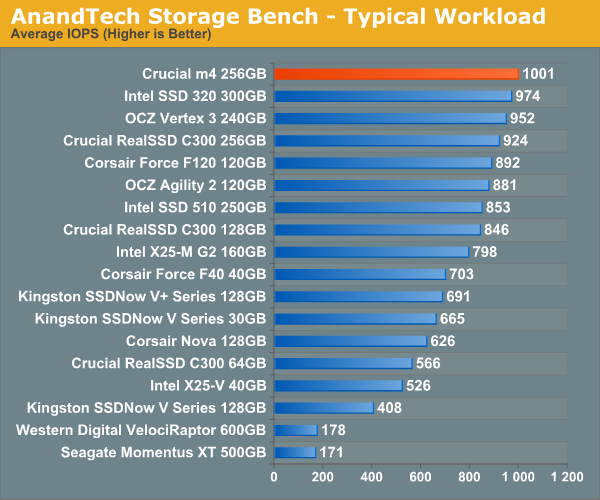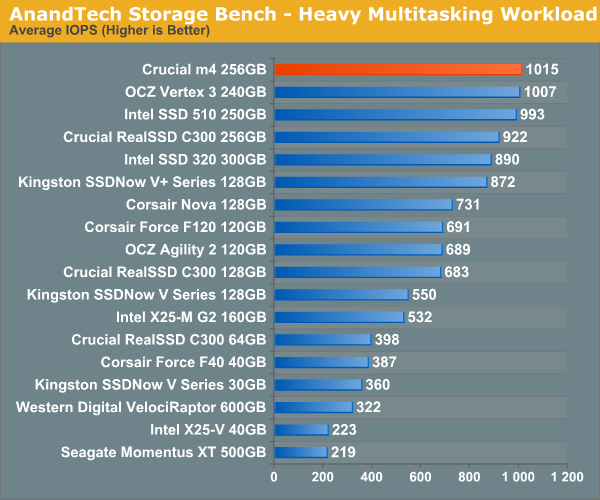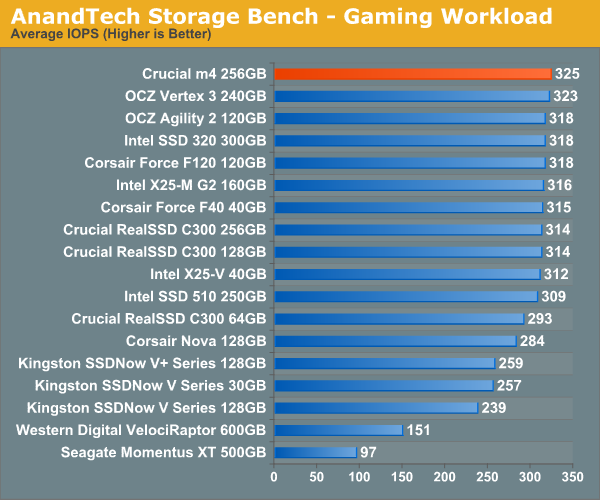The Crucial m4 (Micron C400) SSD Review
by Anand Lal Shimpi on March 31, 2011 3:16 AM ESTAnandTech Storage Bench 2010
To keep things consistent we've also included our older Storage Bench. Note that the old storage test system doesn't have a SATA 6Gbps controller, so we only have 3Gbps results for the 6Gbps drives.
The first in our benchmark suite is a light/typical usage case. The Windows 7 system is loaded with Firefox, Office 2007 and Adobe Reader among other applications. With Firefox we browse web pages like Facebook, AnandTech, Digg and other sites. Outlook is also running and we use it to check emails, create and send a message with a PDF attachment. Adobe Reader is used to view some PDFs. Excel 2007 is used to create a spreadsheet, graphs and save the document. The same goes for Word 2007. We open and step through a presentation in PowerPoint 2007 received as an email attachment before saving it to the desktop. Finally we watch a bit of a Firefly episode in Windows Media Player 11.
There’s some level of multitasking going on here but it’s not unreasonable by any means. Generally the application tasks proceed linearly, with the exception of things like web browsing which may happen in between one of the other tasks.
The recording is played back on all of our drives here today. Remember that we’re isolating disk performance, all we’re doing is playing back every single disk access that happened in that ~5 minute period of usage. The light workload is composed of 37,501 reads and 20,268 writes. Over 30% of the IOs are 4KB, 11% are 16KB, 22% are 32KB and approximately 13% are 64KB in size. Less than 30% of the operations are absolutely sequential in nature. Average queue depth is 6.09 IOs.
The performance results are reported in average I/O Operations per Second (IOPS):

Lighter read-heavy workloads do very well on the m4. Thankfully for Crucial, most user workloads tend to be very read intensive. Over a 3Gbps interface, the m4 is a bit faster than Intel's 320 in our typical workload from 2010.
If there’s a light usage case there’s bound to be a heavy one. In this test we have Microsoft Security Essentials running in the background with real time virus scanning enabled. We also perform a quick scan in the middle of the test. Firefox, Outlook, Excel, Word and Powerpoint are all used the same as they were in the light test. We add Photoshop CS4 to the mix, opening a bunch of 12MP images, editing them, then saving them as highly compressed JPGs for web publishing. Windows 7’s picture viewer is used to view a bunch of pictures on the hard drive. We use 7-zip to create and extract .7z archives. Downloading is also prominently featured in our heavy test; we download large files from the Internet during portions of the benchmark, as well as use uTorrent to grab a couple of torrents. Some of the applications in use are installed during the benchmark, Windows updates are also installed. Towards the end of the test we launch World of Warcraft, play for a few minutes, then delete the folder. This test also takes into account all of the disk accesses that happen while the OS is booting.
The benchmark is 22 minutes long and it consists of 128,895 read operations and 72,411 write operations. Roughly 44% of all IOs were sequential. Approximately 30% of all accesses were 4KB in size, 12% were 16KB in size, 14% were 32KB and 20% were 64KB. Average queue depth was 3.59.

Last year's heavy multitasking workload was also predominantly read heavy. The m4 does very well here again, roughly equaling the performance of OCZ's Vertex 3.
The gaming workload is made up of 75,206 read operations and only 4,592 write operations. Only 20% of the accesses are 4KB in size, nearly 40% are 64KB and 20% are 32KB. A whopping 69% of the IOs are sequential, meaning this is predominantly a sequential read benchmark. The average queue depth is 7.76 IOs.

Gaming performance is good but we're of course bottlenecked by the 3Gbps SATA interface in this test.










103 Comments
View All Comments
MrSpadge - Thursday, March 31, 2011 - link
Wait for the final hard- and software. Some power saving mode was probably not active in this beta version.MrS
Out of Box Experience - Friday, April 1, 2011 - link
The majority of users as of January 2011 were still using XP55% used XP
22% used Windows 7
So for the Majority of users, Intel's 320 series is still the best SSD to get as it uses the same OS agnostic controller that the last Intel SSD's
OCZ on the other hand just purchased Indilynx so we may yet see a OS agnostic controller from them in the near future to compete with Intel in the non-Windows 7 space
This would make perfect sense for OCZ to add the offset to Indilynx controllers to compete for XP users and keep the Sandforce line for Windows 7 users
Although Indilynx does not have the Raw throughput of a Sandforce SSD, it would give respectable performance on "ANY" OS without the need for partition hacks and should be suitable for dual boots if the proper offset is implemented
One of the most basic problems with partition offset hacks for XP was that the offset would be lost if you backup and restore a single partition using Acronis True Image
The only way to keep the offset would be to backup the entire drive!
O&O defrag Pro v14 has a "Manual" Trim command if anyone is interested ???
Controllers that do not include the proper offset for XP boxes generally have horrible "USED" performance after several writes but seem to function OK if you only use them for a boot drive and avoid writes (Hard to do with XP)
Out of Box Experience - Friday, April 1, 2011 - link
Correction:--------------
So for the Majority of users, Intel's 320 series is still the best SSD to get as it uses the same OS agnostic controller that the last generation Intel SSD's had
7Enigma - Friday, April 1, 2011 - link
Could you site your source for those numbers? My hunch is that the people still on XP are likely NOT the same people that will be purchasing these drives. More likely they are on Vista or Win7 which mainly negates your comment.Don't get me wrong I love XP still (my laptop and wife's computer are still running it), but for my main gaming rig (only system with a SSD) I've been through 2 OS revisions (Vista and now 7). Why? DX10/11 support.
And people upgrading existing systems for a SSD are likely upgrading for similar reasons. Few people are going to drop $100-400 for a SSD on a 3-5 year old computer. They are brainwashed into thinking the spyware/virii loaded system is slow because it's old, not because it just needs a fresh install and some proper lockdown/protection.
Out of Box Experience - Friday, April 1, 2011 - link
Sorry, I could not find the exact source that I used but here is a different one with similar resultshttp://www.winmatrix.com/forums/index.php?/topic/3...
Your hunch that people still using XP are likely NOT the same people that will be purchasing these drives is a good bet due to the fact that these drives tend to perform quit badly in a used state when compared to the Intel SSD's on an XP box
This is also the reason I think that OCZ may have purchased Indilynx
To add the offset needed to compete with Intel on the XP boxes
Even if Windows 7 had the same market share "TODAY" that XP enjoys, it is still foolish for SSD makers to ignore that huge XP market at their own detriment
Windows 7 may be the future, but there's gold in them thar XP hills
LeTiger - Thursday, March 31, 2011 - link
With the major players out of the woods now, I guess it's just time to wait until next year to see prices go down. Overall, I can't decide whether I'm happy over a (potentially) knockout performance by OCZ, or sad at the state of Intel/Crucial/etc... offerings...With prices where they still are at this point, I am very satisfied with my 30gb boot drive, and will continue to wait till costs go down until I convert fully over to the SSD realm...
Wave Fusion - Thursday, March 31, 2011 - link
I don't place much faith on that happening.SSDs are selling well enough there's not a good enough reason to reduce prices anytime soon.
At about $1 per GB most SSDs costs more than major parts like the CPU, GPU, RAM and HDD combined.
Allow me to pose a question for a general consensus: All and SSD does better is open files/programs faster and move large files (drive 1 to drive 2) faster; due to its high read/write speeds and more simultaneous operations.
BUT; if you've already run a program once since booting, closed it, then opened it again.. I thought the program was likely cached in the RAM. Which means an SSD would no longer improve anything
The only potential benefit past 1st run would be any data that's never rerun, like media encoding. But the often poorly designed/outdated single threaded programs themselves are a bottleneck way before a HDD is. At least on my machine, even similtaneous
So then I have to ask myself, assuming recently accessed files/programs cached in RAM isn't some myth; what do I really gain from using an SSD?
Why would I spend that money when I could instead use it for an even better GPU or something I actually will notice?
MilwaukeeMike - Thursday, March 31, 2011 - link
Valid point.. but when I use my PC i do a few things frequently that would benefit. I have a kid, and therefore lots of pics and videos, and i play some video games, so i deal with loading screens. I don't ever sit and wait and wish i had 100 FPS instead of my current avg 60. The only times i'm ever looking at my screen and waiting for my PC to finish doing something is either loading a webpage (1-2 seconds) or loading a game (often) or copying files (kinda rare).You're right, if you only use word and excel, this isn't for you. But if find yourself waiting for game screens to load it's worth it. Also, many people have already perfectly fast CPU's/GPU/s and good enough monitors.
The HD is the last slow piece of my computer for me to upgrade.
Ammaross - Thursday, March 31, 2011 - link
Yes, most CPUs bought within the last two years will be more than powerful enough to handle common use. Juicing a system with an SSD will be the best way to regain "lost" performance. Rather than telling your parents to get a new computer when their old one is just "too slow," upgrade their hard drive to an SSD. They likely don't reach 120GB as it is.LeTiger - Friday, April 1, 2011 - link
I would spend the money because for what I do, an SSD greatly benefits my workflow. Tooling around in Lightroom/CS5 all day benefits from an SSD. I just think they are still too much, and when they do get down to the $1 per gig, I will snatch up the biggest one I can afford.As far as "something you will actually notice", you couldn't be more mistaken, an SSD will make the biggest noticeable difference in performance in a computer that you will be able to see. As the comment below says, (and I agree), would you rather watch your FPS meter jump from 60 to 100? or have almost everything you do load very, VERY quickly.
- It made my intel Atom/ION laptop feel as fast as my Quad Core for light usage scenarios, now that is worth spending money on as peace of mind.